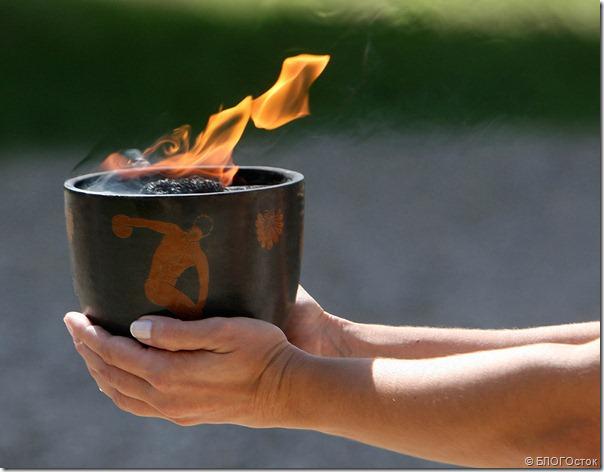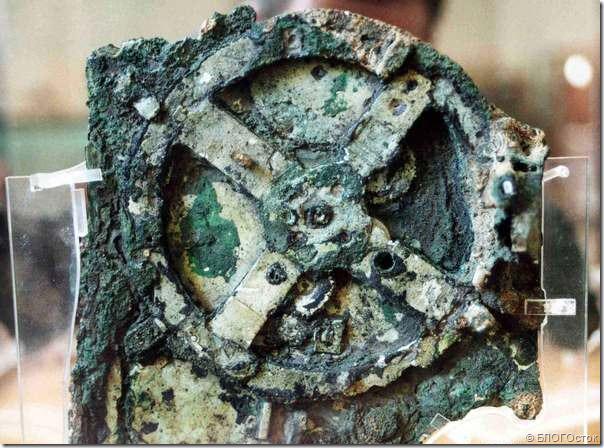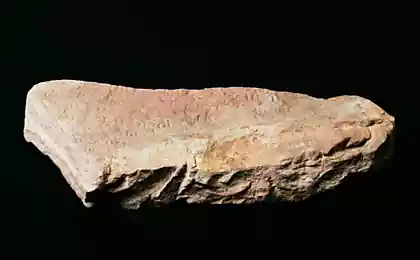939
Five technologies. Lost man
Despite the fact that the modern world is on one of the peaks of technological development, not all knowledge of the past have survived. Actually, it seems as if some inventions were lost, and some of the old technology are incomprehensible to his contemporaries. Here you are offering five lost technologies, which still attract the attention of scientists.
Letters +11 ph via plankinvasya
Roman cement
Modern concrete is a mixture of cement, water and aggregates, such as sand or gravel, it was invented at the beginning of the XVIII century and is the most common building material in the world today. However, the structure designed in the XVIII century, is not the first type of concrete. In essence, the concrete used the Persians, Egyptians, Assyrians and Romans. Recently added to the burnt lime mortar, gravel and water - is this part of Rome gave the Pantheon, the Colosseum, aqueducts and baths.

Like many other ancient knowledge, this technology has been lost with the advent of the Middle Ages - it is not strange that this historical period is also known as the Dark Ages. According to the popular version, a fact which explains the disappearance of the recipe, he was something of a trade secret and the death of those few people who were devoted to her, it was forgotten.
It is noteworthy that the components that distinguish the modern Roman cement, are still unknown. Buildings erected using Roman cement, stood for millennia, despite the impact of the elements - the cement used in our time, can not boast of such resistance. Some historians believe that the Romans added milk and blood in the mortar - it is assumed that the pores that were formed by this process, allow the composition to expand and contract under the influence of temperature changes, while not destroyed. However, the strength of cement crushed other substances, but no one can say exactly what it is.

Technology program "Apollo" and "Gemini»
It turns out that not all of the lost technology originated in ancient times - even relatively recent advances in science and technology may remain incomprehensible to his contemporaries. In the 50s, 60s and 70s of the twentieth century space program "Gemini" and "Apollo" has led to the most notable achievements in the field of human spaceflight. In particular, we are talking about the major successes of NASA, namely, the program "Apollo 11" and the landing of man on the moon. In turn, the earlier program "Gemini" 1965-66. It gives scientists valuable knowledge about the mechanics of space flight. Of course, the achievement of the programs 'Gemini' and 'Apollo' can not be considered to be lost in the traditional sense of the word, because the disposal of scientists are still rocket "Saturn 5", as well as fragments of other spacecraft. On the other hand, the mechanism is not yet possessing requires knowledge of the technology.

The fact that as a result of high rates of "space race" documentation was not as good as desired date of NASA employees. In addition to the rush, the situation is aggravated by the fact that for the preparation of programs to hire private contractors working on individual components of ships and equipment.
Once the programs have been brought to completion, private engineers left, taking with them their drawings and diagrams. As a result, now that NASA is planning a new mission to the moon, large amounts of the required information are unavailable or are in a completely chaotic state. In essence, all that remains of NASA in the circumstances, is to apply to reverse engineering, that is, to the analysis of existing ships.

Damascus steel
Damascus steel, extremely robust type of metal, widely used in the Middle East around 1100-1700 years BC. Basically, this kind of steel became known for swords and knives that are produced therefrom. Blades are forged from Damascus steel, famous for strength and sharpness: it was thought that the sword of Damascus could easily cut stones and other metals, including armor and weapons made of weaker alloys.
Damascus steel is associated with patterned tiglevoy steel from India and Sri Lanka. High strength steel blades of this was due to the production process, during which the hard cementite mixed with a few softer iron, resulting in a product receives both durable and flexible.

The technology of forging Damascus steel was lost around 1750. The exact reason why this happened is unknown, but there are several versions, one way or another to explain those reasons. The most popular theory is that the ore needed to produce Damascus steel, began exhaustive and gunsmiths were forced to move to alternative technologies for the production of blades.
According to another version, blacksmiths, and did not know the technology - they simply forged set of blades and test them for strength. It is expected that by coincidence, some of them were properties that are typical of Damascus. Be that as it may, even at this stage of development of technology is impossible to precisely reconstruct the process of creating Damascus steel. Despite the fact that the blades with a similar pattern exists in our days, to achieve the strength of Damascus steel modern masters, nevertheless, can not.

Greek fire
Greek fire, combustible mixture used for military purposes by the Byzantine Empire and other states - this is one of the most famous of the lost technology. Being something of the original form of napalm, Greek fire continued to burn even in the water. The most famous case of the application of this formidable weapon took place in the XI century, when the Byzantine Empire against the Arabs used the fire and plunged them into flight. Initially, Greek fire was poured into small vessels, which incinerate methane into the enemy like modern Molotov cocktail. Later they invented installation, consisting of copper tubes with siphon - these combat vehicles were used to set fire to enemy ships. In addition, there is information about manual installation, vaguely reminiscent of modern flamethrowers.
Of course, the armed forces of our time using combustible mixture, and therefore can not be said that the technology remains completely unknown. On the other hand, napalm was developed only in the 40s of the twentieth century, and the original structure of the Greek fire was lost after the fall of the Byzantine Empire - so efficient technology, nevertheless, remained lost for centuries. So far it is difficult to say exactly how faded the substance. In addition, scientists do not know what could be used for mixing.
According to the earlier version, the Greek fire would include a large dose of nitrate. However, this version was soon rejected, because nitrate is not lit in the water, and it is this property attributed to the Greek fire. If we believe a new theory, the combustible cocktail was edakii from petroleum or crude oil, as well as burnt lime, potassium nitrate and optionally, sulfur.

Antikythera Mechanism
One of the most mysterious archaeological finds Antikythera mechanism was found by divers at sunken ancient ship near the Greek island of Antikythera in the early twentieth century. Study the following shipwreck, scientists have concluded that the ship dates from the I and II century BC. Thus, the mechanism has been found extremely complicated in its structure: it consisted of more than 30 gears, levers and other components.

Moreover, it uses a differential gear, which, as previously thought to have been invented until the XVI century. Obviously, the device is intended for measuring the position of the sun, moon and other celestial bodies. In describing this mechanism, some experts refer to it as the original form of mechanical watches, while others consider it the first known analog computer.
The accuracy with which the components of the mechanism are formed, indicating that the device did not have a unique. On the other hand, the historical record of the mechanisms whose structure resembles the find dates back to the XIV century, which means that for over 1,400 years the technology has been lost.

Source:
Letters +11 ph via plankinvasya
Roman cement
Modern concrete is a mixture of cement, water and aggregates, such as sand or gravel, it was invented at the beginning of the XVIII century and is the most common building material in the world today. However, the structure designed in the XVIII century, is not the first type of concrete. In essence, the concrete used the Persians, Egyptians, Assyrians and Romans. Recently added to the burnt lime mortar, gravel and water - is this part of Rome gave the Pantheon, the Colosseum, aqueducts and baths.

Like many other ancient knowledge, this technology has been lost with the advent of the Middle Ages - it is not strange that this historical period is also known as the Dark Ages. According to the popular version, a fact which explains the disappearance of the recipe, he was something of a trade secret and the death of those few people who were devoted to her, it was forgotten.
It is noteworthy that the components that distinguish the modern Roman cement, are still unknown. Buildings erected using Roman cement, stood for millennia, despite the impact of the elements - the cement used in our time, can not boast of such resistance. Some historians believe that the Romans added milk and blood in the mortar - it is assumed that the pores that were formed by this process, allow the composition to expand and contract under the influence of temperature changes, while not destroyed. However, the strength of cement crushed other substances, but no one can say exactly what it is.

Technology program "Apollo" and "Gemini»
It turns out that not all of the lost technology originated in ancient times - even relatively recent advances in science and technology may remain incomprehensible to his contemporaries. In the 50s, 60s and 70s of the twentieth century space program "Gemini" and "Apollo" has led to the most notable achievements in the field of human spaceflight. In particular, we are talking about the major successes of NASA, namely, the program "Apollo 11" and the landing of man on the moon. In turn, the earlier program "Gemini" 1965-66. It gives scientists valuable knowledge about the mechanics of space flight. Of course, the achievement of the programs 'Gemini' and 'Apollo' can not be considered to be lost in the traditional sense of the word, because the disposal of scientists are still rocket "Saturn 5", as well as fragments of other spacecraft. On the other hand, the mechanism is not yet possessing requires knowledge of the technology.

The fact that as a result of high rates of "space race" documentation was not as good as desired date of NASA employees. In addition to the rush, the situation is aggravated by the fact that for the preparation of programs to hire private contractors working on individual components of ships and equipment.
Once the programs have been brought to completion, private engineers left, taking with them their drawings and diagrams. As a result, now that NASA is planning a new mission to the moon, large amounts of the required information are unavailable or are in a completely chaotic state. In essence, all that remains of NASA in the circumstances, is to apply to reverse engineering, that is, to the analysis of existing ships.

Damascus steel
Damascus steel, extremely robust type of metal, widely used in the Middle East around 1100-1700 years BC. Basically, this kind of steel became known for swords and knives that are produced therefrom. Blades are forged from Damascus steel, famous for strength and sharpness: it was thought that the sword of Damascus could easily cut stones and other metals, including armor and weapons made of weaker alloys.
Damascus steel is associated with patterned tiglevoy steel from India and Sri Lanka. High strength steel blades of this was due to the production process, during which the hard cementite mixed with a few softer iron, resulting in a product receives both durable and flexible.

The technology of forging Damascus steel was lost around 1750. The exact reason why this happened is unknown, but there are several versions, one way or another to explain those reasons. The most popular theory is that the ore needed to produce Damascus steel, began exhaustive and gunsmiths were forced to move to alternative technologies for the production of blades.
According to another version, blacksmiths, and did not know the technology - they simply forged set of blades and test them for strength. It is expected that by coincidence, some of them were properties that are typical of Damascus. Be that as it may, even at this stage of development of technology is impossible to precisely reconstruct the process of creating Damascus steel. Despite the fact that the blades with a similar pattern exists in our days, to achieve the strength of Damascus steel modern masters, nevertheless, can not.

Greek fire
Greek fire, combustible mixture used for military purposes by the Byzantine Empire and other states - this is one of the most famous of the lost technology. Being something of the original form of napalm, Greek fire continued to burn even in the water. The most famous case of the application of this formidable weapon took place in the XI century, when the Byzantine Empire against the Arabs used the fire and plunged them into flight. Initially, Greek fire was poured into small vessels, which incinerate methane into the enemy like modern Molotov cocktail. Later they invented installation, consisting of copper tubes with siphon - these combat vehicles were used to set fire to enemy ships. In addition, there is information about manual installation, vaguely reminiscent of modern flamethrowers.
Of course, the armed forces of our time using combustible mixture, and therefore can not be said that the technology remains completely unknown. On the other hand, napalm was developed only in the 40s of the twentieth century, and the original structure of the Greek fire was lost after the fall of the Byzantine Empire - so efficient technology, nevertheless, remained lost for centuries. So far it is difficult to say exactly how faded the substance. In addition, scientists do not know what could be used for mixing.
According to the earlier version, the Greek fire would include a large dose of nitrate. However, this version was soon rejected, because nitrate is not lit in the water, and it is this property attributed to the Greek fire. If we believe a new theory, the combustible cocktail was edakii from petroleum or crude oil, as well as burnt lime, potassium nitrate and optionally, sulfur.

Antikythera Mechanism
One of the most mysterious archaeological finds Antikythera mechanism was found by divers at sunken ancient ship near the Greek island of Antikythera in the early twentieth century. Study the following shipwreck, scientists have concluded that the ship dates from the I and II century BC. Thus, the mechanism has been found extremely complicated in its structure: it consisted of more than 30 gears, levers and other components.

Moreover, it uses a differential gear, which, as previously thought to have been invented until the XVI century. Obviously, the device is intended for measuring the position of the sun, moon and other celestial bodies. In describing this mechanism, some experts refer to it as the original form of mechanical watches, while others consider it the first known analog computer.
The accuracy with which the components of the mechanism are formed, indicating that the device did not have a unique. On the other hand, the historical record of the mechanisms whose structure resembles the find dates back to the XIV century, which means that for over 1,400 years the technology has been lost.

Source:























